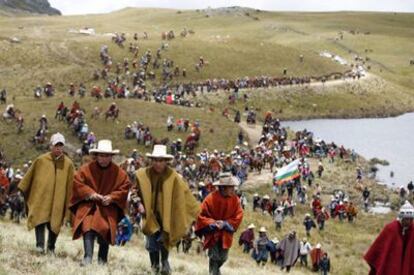Peru's future rests on a gold mine
Humala faces dilemma between keeping a pledge or going ahead with a dig
It takes about three hours on an ATV through a beautiful mountain range from Cajamarca, a city in northern Peru, to get to a place called Quinuapampa and meet José Jesús Chacón.
The 66-year-old rugged-looking man, who has a 40-year-old son, anxiously asks when work in the nearby mine is expected to resume. His son, who worked there, has been unemployed for two months.
Located just a few kilometers from Chacón's home is the so-called Conga project - a controversial $4.8-billion gold and copper mine run by the Yanacocha firm backed with US investments. Yanacocha has already spent $800 million on its operations. It estimates that it will mine between 580,000 and 680,000 ounces of gold and 155 million to 235 million pounds of copper annually.
The extraction will take two years - the mountain on which Chacón lives literally rests on piles of gold, silver and cooper - and Peru stands to collect $3 billion in taxes alone, with Cajamarca getting half that amount. But, at Lima's request, the mine has been closed since November. There is fierce opposition to the Conga project, which is growing nationally and has become a political thorn in the side of the government of President Ollanta Humala.
Mining extraction makes up 60 percent of Peru's exports and rakes in a third of the country's revenue. Investor confidence is crucial to ensuring that the industry continues to steam ahead, and Ollanta's government is struggling with a dilemma over a $4.8-billion investment which, now signed, cannot be canceled because of a campaign promise or local protest.
"The government is determined to respect the democratic system's legal protection, and the contracts that have been signed," says Economy Minister Luis Miguel Castilla.
Chacón lives in a thatched hut on top of a mountain. He has three cows that he takes to pasture some 3,500 meters above sea level. The animals yield about six or seven liters of milk daily. "That's how we survive, sir," Chacón says. Each liter fetches 30 sols (about eight euros) but a sack of rice costs 150 sols (43 euros).
"I hope the mine starts up soon so that my sons can work there. If not, I don't know how we are going to survive; there isn't enough wood and the milk doesn't bring in enough."
Gregorio Santos is the regional president of Cajamarca and the organizer of the opposition movement against the mine. This 45-year-old leftist has been gaining national prominence, and his supporters believe he aspires to a higher office. "The Congo is not going forward," he says.
Authorized in 2010, the project would drain four lakes and stands to completely change the countryside. There is no alternative - the precious metals lie just below the water.
"These are the last water sources that remain in Cajamarca," Santos said.
But Yanacocha's administrators argue that the four lakes are not valley water sources but instead gigantic puddles of stagnant rainwater. This is the discrepancy that is fueling the controversy. The Ollanta government has asked that the project be put on hold until an international team of experts can decide on the importance of these lakes.
The Conga project's administrators have pledged to substitute the four lakes with other artificial bodies of water and build an aqueduct that would double the current capacity to serve the local community.

Tu suscripción se está usando en otro dispositivo
¿Quieres añadir otro usuario a tu suscripción?
Si continúas leyendo en este dispositivo, no se podrá leer en el otro.
FlechaTu suscripción se está usando en otro dispositivo y solo puedes acceder a EL PAÍS desde un dispositivo a la vez.
Si quieres compartir tu cuenta, cambia tu suscripción a la modalidad Premium, así podrás añadir otro usuario. Cada uno accederá con su propia cuenta de email, lo que os permitirá personalizar vuestra experiencia en EL PAÍS.
¿Tienes una suscripción de empresa? Accede aquí para contratar más cuentas.
En el caso de no saber quién está usando tu cuenta, te recomendamos cambiar tu contraseña aquí.
Si decides continuar compartiendo tu cuenta, este mensaje se mostrará en tu dispositivo y en el de la otra persona que está usando tu cuenta de forma indefinida, afectando a tu experiencia de lectura. Puedes consultar aquí los términos y condiciones de la suscripción digital.
Últimas noticias
From Andorra to Gibraltar, a black market for Ozempic exploits its success: ‘They’re the most sought-after products in the world’
From Hungary’s Orbán to Chile’s Kast: How Trump helps turbo charge the far right
Magnets in their heads: How some animals guide themselves using the Earth’s magnetic field
The brief rise and retreat of Generation Z in Mexico
Most viewed
- Why we lost the habit of sleeping in two segments and how that changed our sense of time
- Trump’s obsession with putting his name on everything is unprecedented in the United States
- Charles Dubouloz, mountaineering star, retires at 36 with a farewell tour inspired by Walter Bonatti
- Venezuela faces its most tense Christmas yet
- The Florida Keys tourist paradise is besieged by immigration agents: ‘We’ve never seen anything like this’








































